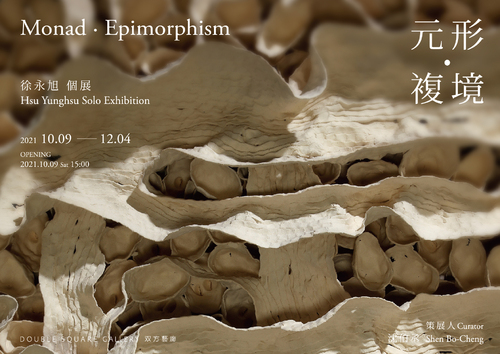Monad.Epimorphism-Hsu Yunghsu Solo Exhibition
“Stand facing the diverse, divergent spatial configuration constructed by Hsu (Yunghsu), one seem-ingly witness the artist distilling his life philosophy and ideation into materials which grasp every essence he encountered in his life: mountain, ocean, earth, air, or even history, society, culture, affects, among others. Overflowing from the artist’s soul and body, they interactively drift into a series of condensed spatial configuration, one after another, seamlessly stacked yet lively poetic.”
-Shen Bocheng, Monad.Epimorphism
Double Square Gallery will present Monad.Epimorphism-Hsu Yunghsu solo exhibition, from October 9 to December 4, 2021. Lately won the Excellence Award in the first Taiwan Ceramics Awards, Hsu Yunghsu is returning to Double Square Gallery for his third show. Since the gallery featured Hsu three years ago, he has been invited by Kaohsiung Museum of Fine Arts and Juming Museum for large-scaled solo exhibitions. This time, on view will be over 20 pieces of artworks created by Hsu over the last three years. 30 years on, Hsu is still devoted to art—pinching with his fingertips, molding with his arms, and even pressing with all his strength to build works larger than life—taking his immense commitment into account, his practice may better be deemed as performance art. Curated by Shen Bocheng, Assistant Professor in Sculpture at National Taiwan University of Arts, the exhibition will re-interpret Hsu’s creation from a fresh perspective, leading viewers to experience the poetic geometry echoed between sculpture and space.
The insight of this exhibition traces back five years to an essay written by Shen Bocheng about Hsu’s works, which left Shen ponder hard over, and constantly make in depth conversations with the artist. As a result, this exhibition hereby is curated to offer viewers a new perspective to look at Hsu’s works. The exhibition is titled Monad.Epimorphism as an attempt to displace us from our usual ways of seeing Hsu’s works by diverting our attention from their texture and size. Instead, the exhibition endeavors to examine the correspondence between shapes of the works and the ambience created around, as well as the interaction between the artist’s body movement and the intrinsic energy released from the artworks. Furthermore, the exhibition begins with the philosophers Leibniz and Bergson’s depictions of the world in order to, by associating with Hsu’s approach of creation, call for an alternative method of interpreting the correlation among the form, body, and trans-dimensional quality in Hsu’s art: Regarding monads of Hsu’s art pieces seemingly develop a sense of agency under the influence of Hsu’s creative attitude and energy, perhaps there exists a sort of mathematical formula which allows us to comprehend the route of connections drawn across his life journey, his works, and the space opened up by his works.
Hsu has long devoted in pursuing art. From the moment he left his position as a teacher for artistic creation, he has dedicated himself to opening up possibilities for pottery. Subsequent to his achievement of winning the Grand Prix at the 8th International Ceramics Competition Mino, Japan for his artwork entitled Transcending Boundaries, Hsu received attention from renowned museums worldwide. In 2018, Hsu was elected as a member of International Academy of Ceramics, UNESCO. Recently, he was honored with the Excellence Award in the first Taiwan Ceramics Awards. Hsu always embraces a bold vision for contemporary sculpture. His ambition drives him to persistently challenge the constraints of magnitude and lightness in ceramic materials, and all the more explore various possibilities. After solo exhibitions in public and private museums, plus a touring exhibition in the United States, Hsu’s view towards artistic creation further sublimes. Like other seekers on the pathway of sculpture, Hsu suffers from long-standing body pain, but still insists on crafting with bare hands. Countless marks imprinted by artist’s palms and body shapes per se are his autographs. In other words, the ceramic works are the by-products of his performance art. Along the artists’ body prints, viewers can feel that fragments of his life burnt into remnants up-on the kiln firing; whereas along the possible interpretation proposed by the curator, acknowledging the relative relation between artworks and space, viewers may glimpse Hsu’s desire to drive internal transformation of the material through his body and mind, and moreover, his endless vitality to question not only the limitation of clay sculpting, but also the perception of dimension and space.
